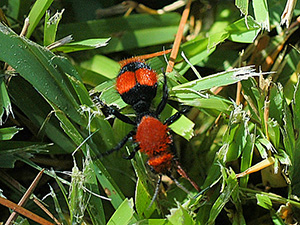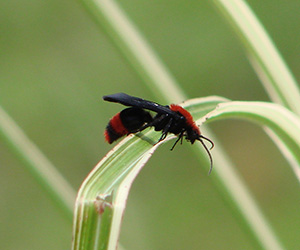Red Velvet Ants
Red Velvet Ants
By Claire Long, Bill Willis, WAIT
August, 2015
No Ant of Mine: Red Velvet Ants Spotted On Campus

Photo courtesy of McEvan
Have you seen these brightly colored “ants” on campus? NIEHS employees have reported multiple sightings, and chances are you might have seen one as well. Despite their name and good looks, the red velvet ants actually belong to the paper wasp family. While they can be found around the world, these “ants” are native to North America.
Their red coat, which can also come in black, white, brown, or gold, serves as warning to predators. Males and females look distinctively different. Female red velvet ants have no wings, which give them their ant like appearance; male red velvet ants have black translucent wings.
In general, these creatures are solitary and non-aggressive, and will often scurry away if they detect you first. Some emit a warning sound to alert potential victims of danger. However, if disturbed (often by someone unknowingly sitting or stepping on them), the female red velvet ant can sting. These insects are also known as mule killer or cow killer ants due to the female ant’s sting, which has been said in urban legends to be strong enough to kill a cow. The venom, although painful, is about like the honey bees in intensity. Male ants do not sting.

Red velvet ants are solitary parasitoid wasps. They do not have colonies with queens, workers, and drones. The bright red exoskeleton of the red velvet ant is very tough, giving them suitable armor to invade other nests without getting hurt. These ants are natural predators of yellow jackets, wasps, and bees. According to North Carolina State University, these ants pose no real threat to humans, livestock, or domesticated animals. Despite the occasional sting, no control measures are necessary.
The red velvet ant is just one of many “stingers” on campus. For information on other such insects, check out the Biters and Stingers of NIEHS flyer.



